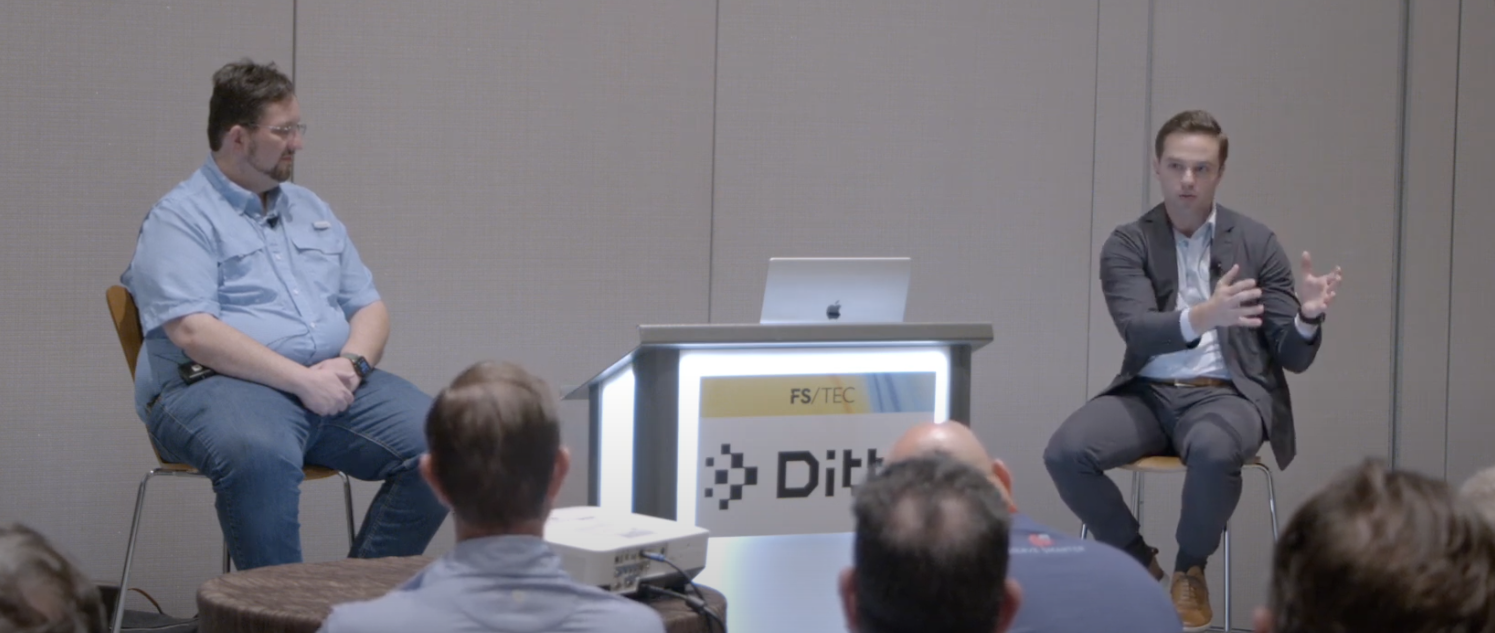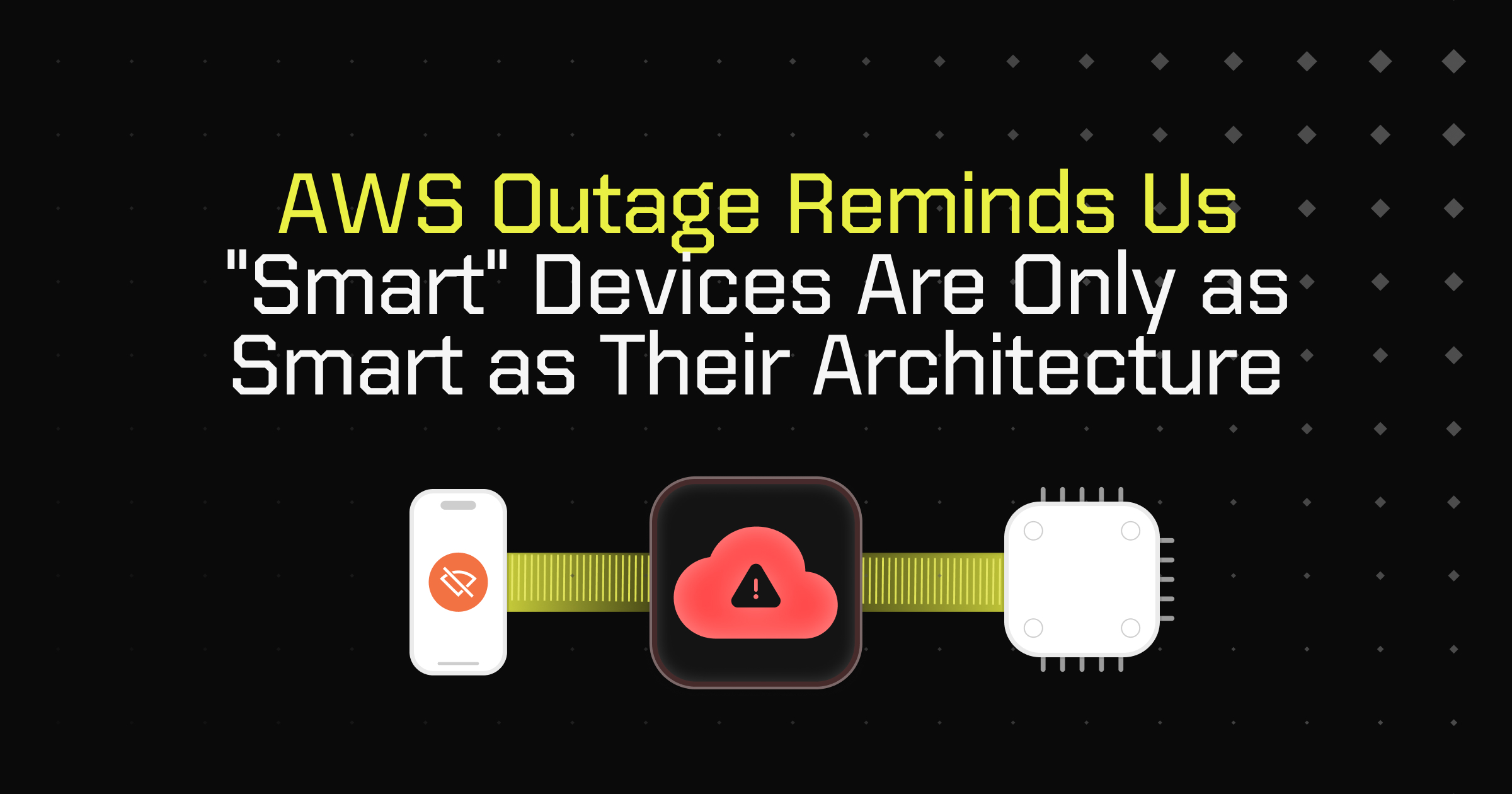Published OnOctober 3, 2025October 3, 2025
Rethinking Restaurant Infrastructure: Top Questions from an IT Veteran at FSTEC
At FSTEC, Freddy’s VP of IT put Ditto’s CEO in the hot seat for a no-sales, candid discussion on the problems with restaurant networking, what lessons can be borrowed from other industries, and how operators should rethink infrastructure for reliability and growth.

At this year’s FSTEC conference, we tried something different. Instead of a standard CEO interview, Sean Thompson, VP of IT at Freddy’s Frozen Custard & Steakburgers, was put in the driver’s seat. He flipped the script on Adam Fish, Founder & CEO of Ditto, and pressed him on his claim that restaurant networking needs a fundamental rethink. Early on, Adam made it clear: “Freddy’s is not a customer of Ditto.” That set the tone for a candid, no-sales conversation—less about any one solution and more about the shared pain points every restaurant brand faces, and the new approaches that might solve them.
The Core Challenge: Brittle Infrastructure in a Mobile-First World
Sean set the tone early: “I know in the restaurant side of things that the most boring and unsexy parts of the business are the most important parts. Because, you know, if nobody’s going into your restrooms to clean the toilets, right? We all know that’s gonna be a bad guest experience eventually, sometimes faster than others.”
Technology, he argued, is no different. When the basics fail, everything else collapses.
Restaurants have embraced mobile devices for speed and flexibility, in the dining room, the kitchen, drive-thru, and patio. While this has been a good change overall for customer experience and efficiency, Adam’s claim is that the shift away from hardwired POS terminals has led to brittleness of the most basic and foundational restaurant technologies.
As Adam recalled, “These were the big terminals that weren’t wireless mobile devices, and they all had to be networked with cables, but they ultimately provided that same capability where data just has to be transmitted device to device versus from a device to a server to another device.”
Today’s systems are often overly reliant on continuous cloud connectivity. When Wi-Fi fails, an ISP hiccups, a router goes down, or a mobile device disconnects because you simply walk into a dead zone, the impact is immediate:
- Orders don’t sync.
- Staff can’t process payments.
- Guests face delays or are asked to return later.
- Guests grow frustrated and leave on their own, perhaps never to return.
Learning from Other Industries: Airlines, Not So Different From Restaurants?
Sean understood the point Adam was trying to make, but challenged Adam to put the technology in plain terms: “How can we take something like that, that’s a behind-the-scenes player, a critical, but a behind-the-scenes player, and put that in a real world example?”
Adam pointed out that airlines faced this same issue years ago, and many still do. Flight attendants needed tools to collaborate on safety checks and in-flight sales, but Wi-Fi at 30,000 feet was never guaranteed. Without direct device-to-device sync, the apps were little more than isolated utilities.
Adam explained how things used to work: “It was effectively like a single-player game. A flight attendant would go to the plane, they would download everything, and then they would go offline because it wasn’t guaranteed that the plane would have Wi-Fi. They could make their own notes, but it wasn’t until the plane landed that any of the other crew would actually see that information… if I can’t share any data with anyone else, it doesn’t really make me do my job more efficiently.”
That single-player problem resonates for restaurants too. When tablets, kiosks, and kitchen display systems can’t share information, each device becomes an island. The result is slower service, disconnected staff, and frustrated guests. The solution in the aviation model can be directly applied to restaurants: let devices sync directly, form their own network not reliant on servers or WiFi, so the whole operation works together even when hardware or internet fails.
Economics Matter: Infrastructure ROI Is Hard to Sell
A recurring theme in the session was how difficult it is to justify infrastructure investments. So Sean brought his finance hat into the conversation: “My CFO lives rent-free inside my head… I’ve always found the hardest thing to convey when it comes to infrastructure is ROI on infrastructure, because it’s not sexy, it’s not flashy…So forget the IT side. Now talk to the CFO—where’s that ROI coming from?”
Adam’s response was to shift the frame: reliable infrastructure isn’t a flashy line item, it’s the protection of throughput, the utility everything else depends on. You could imagine we’re kind of like the power company to your house. Instead of moving power, we’re moving data around.”
In other words, ROI shows up in every order that flows smoothly during a rush, every “lost” order that makes its way to the KDS, every truck roll that doesn’t happen because stores don’t need local servers. The “return” isn’t a single new revenue stream—it’s protecting and amplifying the throughput of the entire operation.
AI at the Edge: Potential and Practicality
No FSTEC discussion would be complete without AI. Both Sean and Adam were clear-eyed about the hype: AI won’t magically cook fries faster. But there are practical uses emerging, such as computer vision for inventory tracking or drive-thru throughput analytics.
The catch? For AI to work in real time, models need to live on devices at the edge—close to the cameras and sensors. That means restaurants need reliable ways to distribute, update, and retrain those models without overwhelming connectivity or staff. The challenge isn’t building the model, it’s managing the data plumbing behind it.
How the EU is Spurring Guest Experience Beyond the Cloud
Sean pushed back on whether this technology really touched the guest: “Team members are happy, their stuff’s not breaking, but we see so much today that obviously a big portion of that revenue coming into a restaurant is gonna be guest ordering and skipping past those point of sales—they’re ordering directly” from their mobile devices.
Adam’s rebuttal was that the guest channel is exactly where the next wave of change is coming from—and it’s being driven by a regulatory shift most operators haven’t even noticed. “Well, sort of hidden in the news was that the EU… actually wanted to break another thing that Apple sort of had a monopoly on, which is the mechanism that powers AirDrop… the new version of iOS that is coming out in the coming weeks will include this open standard.”
The effect is that iOS, Android, Windows, and Linux devices can now all talk directly over Wi-Fi without bouncing through the cloud. If a restaurant were to develop a kiosk that was running on Windows or Linux, that kiosk can now talk over Wi-Fi, which is much more performant than Bluetooth, directly to both iOS and Android devices. Previously, Android would only be able to talk to another Android device, which severely limited your customer base.
Imagine:
- Mobile orders bypass the cloud and sync straight to the kitchen.
- Customer loyalty apps personalize kiosks in real time.
- Drive-thru queues that adapt dynamically based on cars detected in the lot.
For operators, this raises questions of privacy, security, and operational design, but the potential to simplify and accelerate the guest journey is significant.
The Big Picture: Reliability Is Strategy
What emerged most clearly from this FSTEC session is that reliability is not just an IT issue—it’s a brand issue. Guests don’t see the plumbing, but they feel its failures instantly. The challenge for operators is balancing innovation at the front of house with investments in the unseen layers that keep everything running.
The opportunity for the industry is to embrace architectures that:
- Reduce dependence on continuous cloud connectivity.
- Build resilience into mobile-first operations.
- Position restaurants for practical AI and more reliable guest experiences.
As Sean made clear, the brands that win won’t be the ones with the flashiest tech, but the ones that make sure the fundamentals never fail.





